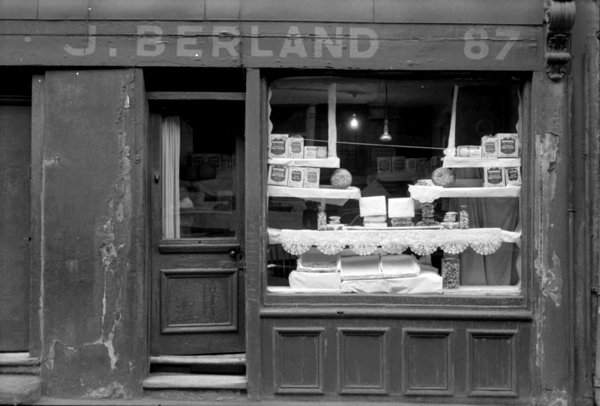Tony Hall’s East End Shops
Tony Hall loved shops, as you can see from this magnificent array of little shops in the East End that he captured for eternity, selected from the thousand or so photographs which survive him.
In the sixties and seventies when these pictures were taken, every street corner that was not occupied by a pub was home to a shop offering groceries and general supplies to the residents of the immediate vicinity. The owners of these small shops took on mythic status as all-seeing custodians of local information, offering a counterpoint to the pub as a community meeting place for the exchange of everybody’s business. Shopkeepers were party to the smallest vacillations in the domestic economy of their customers and it was essential for children to curry their good favour if the regular chore of going to fetch a packet of butter or a tin of custard, or any other domestic essential, might be ameliorated by the possibility of reward in the form of sweets, whether there was any change left over or not.
Yet, even in the time these photographs were taken, the small shops were in decline and Tony Hall knew he was capturing the end of a culture, erased by the rise of the chain-stores and the supermarkets. To the aficionado of small shops there are some prize examples here – of businesses that survived beyond their time, receptacles of a certain modest history of shopkeepers. It was a noble history of those who created lives for themselves by working long hours serving the needs of their customers. It was a familiar history of shopkeepers who made a living but not a fortune. Above all, it was a proud history of those who delighted in shopkeeping.
SIGN THE PETITION TO SAVE OUR SHOPKEEPERS FROM THE NEW BUSINESS RATES
Photographs copyright © Libby Hall
Images courtesy of the Tony Hall Collection at the Bishopsgate Institute
You may also like to read
Libby Hall, Collector of Dog Photography
and take a look at these other pictures of East End Shops






















































Your site really is a time machine of the mind, GA. Turog bread! I haven’t seen or heard of it for years. You’ve also rekindled an important philosophical question – whether the anecdote about some servicemen’s naughty wives putting cartons of OMO in the window was true or apocryphal.
Seriously, I think one can make the case that the disappearance of this sort of shop goes a long way to explain the modern dilution of local senses of community. Whatever our least pleasant politicians say, it’s far less to do with ethnicity than opportunities to socialize.
An extraordinary collection of photographs. Absolutely marvellous!
Wonderful photos, bringing back childhood memories of buying sweets for a penny at the corner shop on the way to school….Valerie
Another great post from GA that triggers many memories from the ’50’s 🙂
Love these photographs. Really miss these proper shops. These were the real deal not hispter pastiches!
Wonderfully nostalgic photographs – brands from the past and green shield stamps!
These are so evocative. I can even smell the inside of the shops. And, so few cars.
As a time traveler, I’ve just landed at W. Richardson & Son, and am making my selections. Artists often find better prices in hardware stores, rather than upscale art stores (same goods!) and I would have an absolute Field Day in Richardson’s. I am imagining the sights and smells inside – perhaps a whiff of solvents, and the scent of the wooden floors. I’ve taken all my discoveries to the cash register, where even more “impulse buys” tempt me. All in all, a wonderful morning.
Back to the studio to make things!
Wonderful photographs. Thank you so much. They give me endless inspiration for recreating these little treasures and their stock, in 1/12th. scale, warts and all! Well stocked and prosperous or struggling to keep going, they all added to the lives of those who lived nearby. A sad passing of a tradition.
The butchers shop No173 was in Brick Lane. His son died recently
I recognise the derelict “furniture” shop with the wooden handcart parked outside.It was on the corner of Hackney Rd/Yorkton St….you can see St Augustine’s Church and Vicarage in the background.I spent many evenings there during the early 70’s when it was the clubhouse venue for The 59 Club.It’s all luxury apartments now.
Hello, Jim McDermott what was the omo in the window meant to signify regarding services mens wives . When I was a kid , 70s, there were alot of shops that had it in the window .
What you said about the shops is true.
Jim McDonald, dont tell me it meant for those interested I’m “on my own”.
Was it a war thing only aimed at American service men or did it continue into 50s 60s 70s.